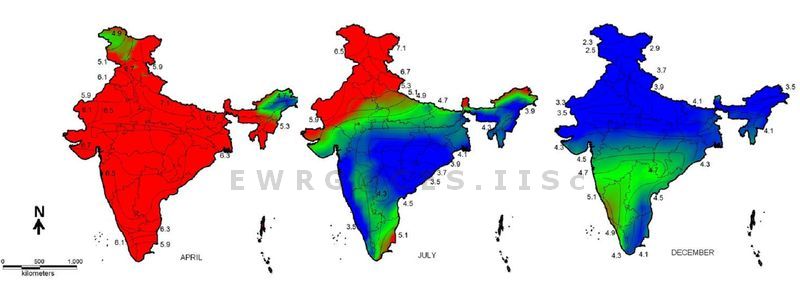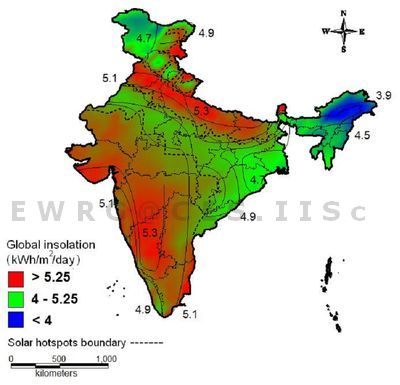|
The population of India has peaked to 1.21 billion and over 60,000 villages in the country are not electrified. Energy security is one of the biggest challenges that the country faces today. Coal based power generation shares over 50% of the installed capacity in the country and meets the major power requirements. This is associated with local and global environmental pollution with resultant impact on air, water, land and biodiversity. Energy planning in the country continues to be focused on supply side rather than demand side variability. Losses during transmission and distribution at a national average of 27% reflect the need for a paradigm shift from centralized to clean and decentralized power generation based on renewable resources and push for endues efficiency improvements. This also underscores the huge opportunity for energy conservation and renewable energy technologies, particularly solar energy in the tropical regions.
Solar Potential in India: Scope and Challenges
Installed power capacity in India is 187549.6 MW out of which renewable energy share is 20162.2 MW (nearly 11%). India receives solar energy equivalent to more than 5,000 trillion units per year. Further, the daily average solar energy incident per unit area (m2) varies between 4–7 units, much in accordance with the location. Also, most parts of the country have about 300 clear sunny days. All these augur well for solar energy development through well devised policy-cum-programme initiatives. In this context, the Jawaharlal Nehru National Solar Mission (JNNSM) was launched in 2010 and there has been a dramatic change in the way solar technology is perceived. The mission was launched at a time when the price of solar modules was declining by almost 50%. This has made Solar Photovoltaic (SPV) systems more affordable and accessible than ever before. The Concentrated Solar Power (CSP) technologies, particularly parabolic trough based systems are mature enough for commercial power generation. It is now widely believed that the solar mission targets are achievable. Among the broad targets of the mission, capacities of 20,000 MW, 100,000 MW and 200,000 MW are targeted for 2022, 2030 and 2050 respectively. The period 2022–2050 is expected to generate an investment opportunity of INR 850,000 -1,050,000 million. Realization of the targets will make India a global leader in solar energy.
Region-specific solar energy variability
Availability of solar energy is influenced by geographic and climatic factors apart from daily, monthly and annual variations. Region-specific considerations play pivotal role in the techno-economic viability of solar power generation. Since massive investments are involved, it is very important for the government and the private players to perform solar technology performance analyses. The project developers need to study local conditions with a clockwork precision.
A study was undertaken to quantify the regional variability of solar energy and identify hotspots of solar potential that are viable for large scale solar power generation in India. The study strategically informs investment-specific decisions for potential solar power developers as well as policy decisions for energy planners. A techno-economic analysis of solar technologies like SPV and CSP was also undertaken. Investigation of regional variability of solar energy in our vast country with sparse radiation data from merely 45 stations is futile. Hence, the study was carried out with high spatial resolution NASA meteorological dataset that is available for a period of 22 years. Radiation data was available for over 350 locations in India and monthly maps depicting solar energy availability were created to analyse the regional variability Above 5.25 kWh/m2/day of global horizontal solar radiation is considered excellent while that from 4–5.25 kWh/m2/day is considered good. The analyses of monthly solar energy availability (Figure 1) concluded that global insolation throughout India increases from January to May (gradually from south to north India) and decreases after May with the onset of monsoon. The average variation of solar radiation with area within the dotted lines indicates places with radiation over 5 kWh/m2/day; these are considered to be the hotspot of solar potential in India (Figure 2). It was found that the gangetic plains, the plateau region, the western dry region, Gujarat plains and hill region, west coast plains, and ghat regions receive annual global insolation above 5 kWh/m2/day. These zones include states such as Karnataka, Gujarat, Andhra Pradesh, Maharashtra, Madhya Pradesh, Rajasthan, Tamil Nadu, Haryana, Punjab, Kerala, Bihar, Uttar Pradesh, and Chhattisgarh. The eastern part of Ladakh and some parts of Himachal Pradesh, Uttarakhand, and Sikkim which are located in the Himalayan belt are also solar hotspots. These cover nearly 1.89 million km2 (~58%) area of the country and present favourable prospectsfor solar energy utilization. (Ramachandra et al., 2011).
Figure 1: Seasonal variation of solar energy availability in India ( representative months, April – Summer, July – Monsoon, December – Winter)

Figure 2: Solar hotspots demarcated over the annual solar energy map of India

Solar energy: The hope for today and tomorrow
Solar hotspots in India uphold the prospects as major hubs of clean power generation to meet the ever increasing electricity demands coupled with the diminishing stock of fossil fuels. This necessitates the region specific availability and variability analysis. Thereafter, a clear understanding of relevant solar technologies is required from a variety of end-use considerations. The Indian landscape is well suited to be dotted with SPV and CSP plants and the country is poised to be the leader with the energy secure future (Ramachandra and Krishnadas, 2011).
SPV: The SPV is a semiconductor based technology, which converts sunlight directly into electricity. ASPV-based system, without battery backup on-site, may actually be able to provide just about 67.5% of the maximum power output, on a clear sunny day. This is attributed to factors, such as time of the day, internal heating, dust, module mismatch, wiring, and DC-AC conversion losses affecting the overall system performance. If, a battery is added to the system, the net power output may further reduce by 6%–10%. The European Photovoltaic Industry Association (EPIA) and Greenpeace predict that by 2050, solar power will meet about 21% of global electricity needs. As per the current estimates, more than 3 million people, globally, benefit from small SPV systems. Also, the per peak watt price of solar modules in India is less than INR 100 and is further on a decline. India currently has few major grid interactive SPV plants and a lot more are being commissioned through private participation in the best sun-soaked regions of Karnataka, West Bengal, Maharashtra, Punjab, Rajasthan among others. The grid interactive SPV capacity in the country has grown nearly 10 times from pre-JNNSM to 481.8 MW as of today.
CSP: While SPV modules are capable of using global solar radiation, direct solar radiation above 5 kWh/m2/day is congenial for CSP applications. Sun rays are concentrated to focus on a point or a line where the boiler unit is placed. Depending on the design of the plants the temperature may vary from 300–1500 °C. Heat collected in a CSP plant can be stored in various forms for later use and this makes it distinct benefit from SPV technology. Also, it is relatively simpler and cost effective as compared to conventional battery storage that is used with SPV. The CSP plants require about 2 ha (20,000 m2) in semi-arid and arid regions with clear skies. It is very important to have knowledge of yearly direct solar insolation data prior to their installation. Nearly 50% of the investments in CSP-based power plants is used to purchase locally available materials like steel, mirrors, concrete, besides the labour cost. It, thus provides socio-economic stability and local employment opportunities. Undeniably, CSP adapts well to the Indian socio-economic conditions, but needs vigorous research and development for up-scaling. In the present context, serious efforts are underway to design and develop CSP plants suitable for Indian conditions. Research centers at premier institutes like Indian Institute of Technology (Rajasthan) are forging ahead in this direction.
Conclusions: India can be a world leader in solar power generation with about 58% of the region are solar hotspots receiving annual average Global insolation of >5 kWh/m2/day. Exploiting solar resources locally would help to meet the escalating power requirements in a decentralized, efficient and sustainable manner. However, a major thrust for R&D in solar technologies is required to optimize the generation cost and enable a competition with the conventional fossil fuel based options. Solar hotspots in India have the potential to offset a huge volume of GHG emissions as demonstrated and help realize a low carbon economy at a faster rate. Ambitious solar mission, conducive academic environment coupled with an appropriate policy instruments, the nation will rightly adorn the epithet of ‘Solar India’ in the near future.
References:
- Ramachandra T V, Rishabh Jain and Gautham Krishnadas, 2011. Hotspots of Solar Potential in India, Renewable and Sustainable Energy Reviews, 15(6):3178-3186.
- Ramachandra.T.V. and Gautham Krishnadas, 2011. Decentralized renewable energy options for Himalayan states in India., 7th National Conference on Indian energy sector "SYNERGY WITH ENERGY", November 18-19, 2011. AMA, Ahmedabad., pp. 80-86.
- http://wgbis.ces.iisc.ac.in/energy/
|



